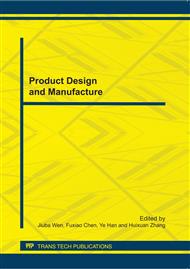p.32
p.36
p.42
p.47
p.51
p.56
p.61
p.65
p.70
FEM for Brake Discs of SiC 3D Continuous Ceramic Reinforced 7075 Aluminum Alloy for CRH3 Trains Applying Emergency Braking
Abstract:
The shaft disc prepared with SiC 3D continuous ceramic frame reinforced aluminum alloy 7075 (3D-SiC/Al) composite of the CRH3 high speed train with a speed at 250 km/h was chosen as the research object, and the course of emergency brake was simulated by Cosmos. A three dimension model was established, the way of applying loads were discussed, and the temperature field and thermal stress field were obtained. The result shows that the highest temperature appears at about 57 s since braking and the value is about 373 °C. The biggest stress is about 237 MPa, appearing at about 51 s since braking, the regions distribute at the surface corresponding with the radiating ribs, and near the inner diameter. The hoop stress is larger than other directions. The result shows that the thermal stress duce to the transient temperature distribution model is released well for the distribution of the 3D continuous ceramic frame reinforced aluminum alloy 7075 structure compares with the conventional brake disc, which can satisfy the requirement of the shaft disc of the high speed train with a speed at 250 km/h applying emergency braking.
Info:
Periodical:
Pages:
51-55
Citation:
Online since:
October 2011
Authors:
Price:
Сopyright:
© 2012 Trans Tech Publications Ltd. All Rights Reserved
Share:
Citation:


